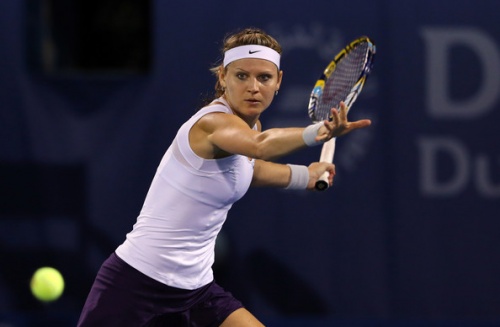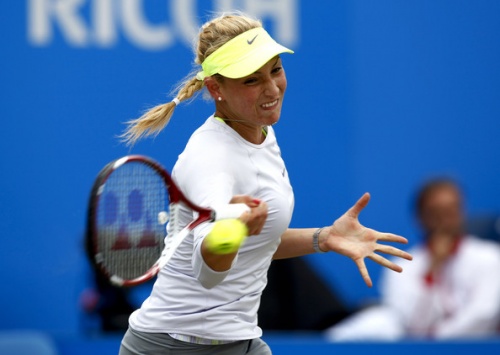Don't miss any stories → Follow Tennis View
FollowOuter Court Chronicles: Around the Grounds on Day 2
As fans pile onto the grounds of the Billie Jean King National Tennis Center, they likely open up their schedules at the beginning of the day and plan around what is scheduled on the stadium courts: Arthur Ashe, Louis Armstrong and Grandstand (and maybe Court 17). The way that the US Open organizes its schedule fosters the notion that, when it comes to quality in tennis, size matters. Surely, the biggest courts are home to the biggest names, ergo the best players, right? Perhaps, but none of those things guarantee compelling tennis, particularly in the early rounds where the talent gap between the best players and their opponents tends to be as wide as it will be the entire fortnight. It is a different story beyond the stadiums. There, compelling matchups abound that give fans the opportunity to see quality play and a chance to get to know the players who make up the backbone of the Tours.
Things got started bright and early on Court 9 between former top 20 player Lucie Safarova and dangerous floater Lesia Tsurenko…
Tsurenko, currently ranked No. 61 in the world, has played better than her ranking suggests in 2013. Her summer, however, has been slowed by a troublesome right thigh injury. Suffered in Bastad, her injury led to a retirement in Washington and withdrawals from Toronto, Cincinnati and New Haven. The ever-dangerous Safarova has suffered a dip in form this season. Her ranking dipped from No. 17 to start the year to No. 41 coming into Flushing Meadows. In addition, the Czech has not won back-to-back matches since Eastbourne, and she came into the day on a four-match losing streak.
Both players showed glimpses of their shotmaking ability, with flashy winners flying from Tsurenko's backhand and Safarova's forehand, but the lack of confidence from both players was also evident. Neither player would call momentum her friend even in top form, and both appeared incapable of playing well at the same time. Safarova's ability to hit a slightly bigger ball gave her an early advantage to open the third set, which she seemed poised to maintain. It seemed as though the Ukrainian would be given new life when Safarova tightened up when serving for the match at 5-3 in the third set. Three errors from the Czech and a backhand winner from Tsurenko put the match back on serve. But, to stay in the match, the Ukrainian was forced to do two of her least favorite things: serve and hit forehands.
Neither of these things went very well.
Credit to Safarova, who directed all traffic to the weaker wing of her opponent in the final game and a final forehand error (what else?) from Tsurenko sent Safarova safely through to the second round by a 6-3 2-6 6-4 scoreline.

Right next door, things were much less complicated for Russia’s Elena Vesnina on Court 10. In the midst of a stellar year, Vesnina has won Hobart and Eastbourne in 2013, the first two singles titles of her career. Taking on unseeded Annika Beck to begin her US Open campaign, the No. 22 seed looked to be in for a tough morning against the young German, who took a set from New Haven finalist Petra Kvitova less than a week ago.
What followed was an absolute master class from Vesnina. The 2013 French Open women’s doubles champion had an excellent serving day, giving Beck no looks on the return, and put pressure on the German’s already shaky serve. With the sun going in and out as play began, the veteran Vesnina dealt well with the changing conditions, popping seven aces and placing countless other serves that allowed her to end points quickly with some crafty forays to the net. Beck managed to work some rallies to her advantage but generally lacked the wattage off the ground to make Vesnina uncomfortable, quickly succumbing to the Russian’s barrage 6-1 6-1.
Sitting smack in the middle of the Caroline Wozniacki/Roberta Vinci section, Vesnina has the opportunity to do big things on a surface where she’s already had success, including a win over Vinci en route to the second week of this year’s Australian Open. A straightforward result need not imply that a boring match was played. With her mix of power and flare, Vesnina proved that straightforward tennis could actually be thoroughly entertaining.
If only the combatants on Court 6 had gotten that memo…
While all eyes were focused on 17-year-old Victoria Duval, the rising American who shocked 2011 US Open champion Samantha Stosur, another 17-year-old was looking to advance to the second round on a much smaller stage. In the shadow of Arthur Ashe Stadium, Donna Vekic had her hands full with an inspired Mariana Duque-Marino.
The Croat sought to hit through the Colombian's defense in the opening set, but she found little success. Conversely, Duque-Marino found a wealth of success with the forehand drop shot. In a set where there was little to separate them, Duque-Marino went to the well once too often for the drop shot, and a crucial error off that shot in the first set tiebreak gave Vekic a mini-break and helped her seal the first set. Vekic exerted incredible amounts of effort to try and track down many of Duque-Marino's trick shots. But eventually she decided that her efforts were best spent elsewhere.

Perhaps frustrated with her level of play against an opponent with no hard-court pedigree, Vekic channeled her frustrations into questioning several (correct) line calls in the first set.
While we're talking about line calls, Vekic looked poised to close the match in two when she led Duque Marino led by a set and 4-4. As so often happens in tennis, however, the young Croat was broken to force a third set of an already long and ugly match. Flustered with a line call that gave Duque Marino set point, Vekic appealed to the chair as the fans of her Colombian opponent began shouting that they had seen Vekic’s ball go wide and their charge deserved the point.
Er…
First of all, there is no “Ask the Audience” segment in tennis. The umpire’s decision is final, and how you, the spectator, see the ball, is utterly irrelevant.
Secondly, claiming that they saw a ball float wide when your view is obstructed by an electrical box did little but highlight their already shattered credibility.
Moving on…
After two sets of error-strewn tennis, something had to change before Court 6 folded in upon itself and imploded. At least, by that point, the quality of play had improved to where the heat-exhausted crowd were treated to some head-exploding winners by Vekic, including a backhand down the line at full stretch. Duque Marino forced Vekic to serve for it, but the young Croat’s forehand had clicked in for good. There would be no comeback for the Colombian, who was forced to watch a searing forehand winner seal her fate.
Tennis on an outer court can be flawless and masterful, dramatic and full of shifts in momentum, and even downright ugly at times. But a spin around the grounds can yield its fair share of hidden gems, if fans are willing to descend from Arthur Ashe’s upper deck to take a look.










